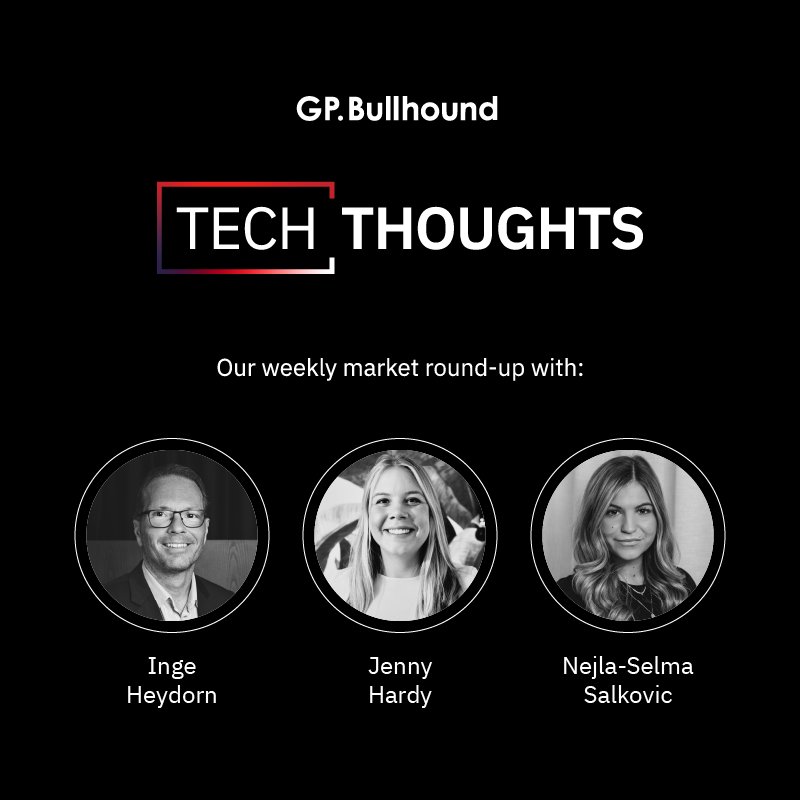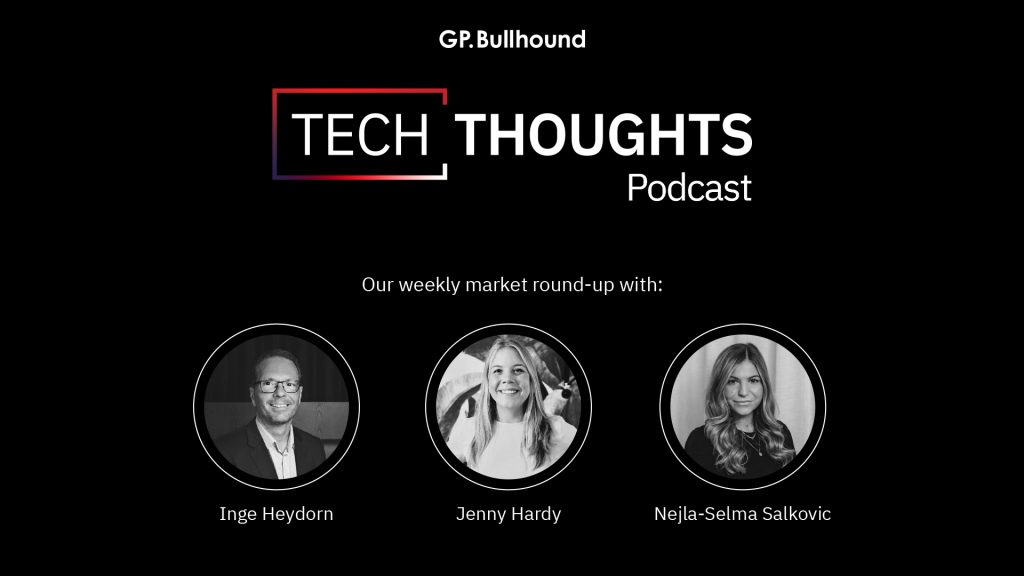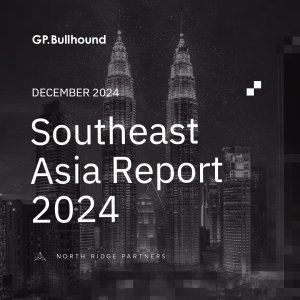Tech Thoughts Newsletter – 21 July 2023.

Market: Results kicked off in earnest this week, so finally some fundamentals for the market to focus on rather than just inflation and interest rates… except that most earnings calls we’ve listened to are CEOs and CFOs talking about inflation and interest rates and the negative impact that’s having on demand. A confluence of pretty damp results and some guidance downgrades (which we run through below) saw quite a tough week for tech.
Portfolio: we’ve taken some risk off in the portfolio this week as we’ve started to see more evidence of macro weakness. We’re delaying our expectations of a recovery and so it’s right to shift the portfolio composition to reflect that. We haven’t bought any new names or sold any of our holdings but we have shifted some position sizing.
Straight into results:
TSMC (owned) reducing its full year guide – AI strength but weakness everywhere else
- We already had TSMC’s Q2 revenue from its monthly sales releases, coming in -5% qtr/qtr, at the higher end of the original guidance range.
- Important for our semicap exposure (ASML below), there was no cut to capex – they’re keeping the $32-36bn guide (at the lower end – which they told us at their annual shareholders meeting in June). So better (or at least not worse) news for the semicap space.
- Q3 guidance is $16.7-17.5bn, +9% qtr/qtr, $1.3bn incremental revenue qtr/qtr. Q3 is typically +15-20% growth qtr/qtr, driven by new product ramps (Apple) – so the lower than seasonal growth speaks to weaker overall demand (particularly weak non Apple iPhone demand – China called out) and still high chip inventories.
- For the full year, they’re now guiding for revenue to decline 10%, where last quarter they had expected low to mid-single digit.
- They’re still outperforming the foundry space (which will decline in the teens) but it’s clear that the inventory digestion is taking longer than they expected – and while it should bottom in Q3, the build back is delayed given the macro.
- The macro has clearly been much weaker than expected at the start of the year (or rather – as we know from the PC and smartphone numbers there’s still no tangible sign of recovery – so we’re rather stuck in a long “U” shaped hole, rather than the hoped for “V”), and the inventory situation is clearly still tough, with much more to work through, than anyone thought at the start of the year – TSMC can’t get away from that.
- The bright spot in demand is AI – which we talk more through as it relates to the portfolio below. TSMC are making as many AI chips as they can (and we know Nvidia remain sold out through to at least Q1 next year) – and our above consensus view on Nvidia is focused around them being able to ramp supply as Apple volumes shift to the next node – this is happening. The bottleneck now appears to be back end CoWoS “chip on wafer on substrate” capacity – which helps chips maximise the interconnect density.
Portfolio view: Overall TSMC’s formula of outperforming the semis market and foundry is still working, and they’re managing their business well in terms of cost control, but there’s no escaping the inventory digestion for the whole industry is taking longer.
For us what’s important given portfolio exposure (Nvidia, AMD) is the AI demand (TSMC will build all of Nvidia’s H100 and A100 chips) – and that is the one area of strength they call out: “other than AI everything else is seeing weakness in the second half”. The difficulty is that clearly in reducing its full year guide, the range of outcomes for the whole sector is skewed more negative. TSMC are unable to fulfil AI demand (which speaks to our view on supply/demand for Nvidia’s H100/A100 chips) – in particular it’s their packaging “CoWoS” capacity that’s the constraining factor currently: “it’s very hard to fulfil 100% of what the customer needs”, but that isn’t offsetting the broader cyclicality in other areas. The difficulty is the balance – if the cyclicality of the other end markets is much worse than we had anticipated, and Nvidia is filling more of the downside, that’s good news – but there’s also a scenario where Nvidia capacity isn’t coming through as quickly as we hoped – it’s something we just don’t know yet.
As we’ve said before we try to limit exposure to the broader areas of weakness in the semis space – in particular non-Apple smartphone – and we note too the profit warning from Sunny Optical this week (a proper profit warning – H1 profit will decline 70% and will miss estimates by over 60%) – it shows there are really still no signs of life in the Android market.
On capex and our semicap exposure: TSMC keeping its capex guide is good news. Intel and Samsung both report next week so ears out for any update on their 2023 capex plans (Intel hasn’t formally provided guidance but did talk about a low 30s capex/sales figure – we estimate ~$20bn gross capex, and ~$16bn net, against a ~$50bn sales estimate which would be 32%). Samsung reiterated its production cut at its April results and guided for a similar capex spend as 2022 ($42bn)
ASML – still seeing strong demand, order book increasing
- ASML beat consensus expectations for Q2 and guided ahead for Q3. It also upped its full year 2023 guidance to 30% revenue growth (from 25%), partly on revenue recognition (accounting) but also on stronger demand for its tools.
- Importantly the forward-looking order number of €4.5bn showed an increase on Q1’s €3.8bn, which is a good sign of the cycle bottoming.
- Demand for ASML machines remains strong – the backlog is €38bn – that’s about two times the system sales that will be recorded as revenue this year. Customers have orders in the book, far exceeding ASML’s ability to supply and covering shipments extending well beyond order lead times.
- Within the details, it was DUV machines in particular which were seeing high demand, exceeding supply – in particular any push outs that are happening at some players are being filled by China.
- While US export controls are preventing China from receiving leading edge machines, they can still receive equipment to build out trailing or more mature node technology. Our view is that it makes a lot of sense for China to try to build up a very strategic position in trailing edge semiconductor manufacturing.
- EUV is seeing some delays in fab-readiness related to “skills issues” in both Taiwan and the US. It’s not entirely unexpected – there have been reports of TSMC and Intel both struggling to hire qualified engineers – and TSMC spoke about it on their call – although said it shouldn’t have a material impact on their capex plans. It’s important for the broader space, because TSMC’s Arizona fab is a key part of 5/4nm capacity which we think has been allocated to Nvidia and Apple, and specifically would be expected to meet the current high demand for Nvidia’s H100 chips. It means AI chips may be even more supply constrained than we had thought.
- One of the best reads ASML has on the industry is their equipment utilisation – historically it has been worth following their observations for early indication of a cycle recovery and positively they said they felt we might have passed the inflection in logic, while memory was “bottoming out”.
- Relatedly Disco, a Japanese back end equipment supplier (which we don’t own) also saw a sequential increase in orders so it does feel like this part of the sector might be seeing a bottoming.
Portfolio view: semicap and ASML remain core holdings for us. ASML will deliver outsized growth and returns within the semis sector and within tech this year (30% top line profitable growth is hard to come by anywhere this year!) – and indeed that it can continue to see growth next year.
AI and enterprise software monetising
- Salesforce (owned) price increases last week. This week, both Microsoft (owned) and Salesforce announced explicit pricing for their Generative AI products.
- Microsoft at its partners conference announced that M365 Copilot pricing was $30/user/month. Back of the envelope ~400m commercial Microsoft 365 users, 30 x 12 x 400m = $144bn of potential annual sales increase…
- Salesforce followed the next day announcing its SalesGPT pricing – $50/user/month.
Portfolio view: we’ve commented so many times that it’s so important to have business models that make sense in AI. Because the Nvidia chips are so expensive!! AI as an enterprise software opportunity makes sense. Established enterprise software businesses who are able to (1) leverage very large installed bases to upsell AI features; (2) have large cash balances to invest in AI; (3) have the right business model for AI to match the increased cost – ie. subscription, not pay per click (like search..)
It also speaks to why we were much less excited about Bing than we were Microsoft’s Office as an AI opportunity ($144bn isn’t far off Google’s $163bn search revenue last year – I know where I’d focus my efforts vs trying to displace 20 years of cumulative habit…).
And of course – as Salesforce shows, it’s an opportunity for all enterprise software businesses. And for enterprise software customers it makes much more sense to get AI capabilities via their existing platform software providers than to try to implement it themselves.
Pricing power might be missing from the streaming industry…
- Netflix (not owned) – reported “ok” results (slightly damp guidance) but as has often been the case with highly rated stocks in a rising interest rate world, “not enough to justify the multiple”. Netflix grew its top line 2.7% in Q2.. good for a telco, not good for tech.. And especially not good for a stock trading on over 40x this year’s EPS…
- There were better subscriber numbers but damper revenues – unexpected dynamics (because paid sharing should be an implicit ARPU upgrade) , and it feels like the mix has changed from pricing growth last year/earlier this year, to subscriber growth without ARPU (and guidance implying that pricing pressure will remain).
- Netflix is supposed to be differentiated (and therefore should be able to exercise pricing power – without causing churn) through its content. The issue is that there’s so much content out there, and so many players with large pockets funding new content, that streaming might have turned into a commodity business too. (We’ll save any actors strike commentary/impacts for a quieter week!)
Portfolio view: we sold Disney on concerns around the long term returns in the streaming industry, as well as its mission creep from differentiated “core” Disney content. Now our only real exposure to streaming is through Sony, who is the perfect non-streaming streaming player, benefitting from the content inflation in its Pictures business without having to run a cash flow negative streaming platform!
Autos news – Stellantis long term agreements show importance of semis
- Most important/interesting news in autos this week was Stellantis announcing an agreement on ordering €10bn of auto chips through 2030 as part of a long term pricing agreement. We’ve commented before on the increasing prevalence of LTAs across the industry and what it means for semis pricing (more visibility). Stellantis specifically called out Infineon (owned), NXP (owned), onsemi and Qualcomm as strategic semi suppliers, and specifically talked about SiC (which Infineon has high share in).
- Tesla’s results showed it’s still producing and selling ahead of its targets (as we already knew from tracking its monthly data). The damp spot is clearly margins, given the slew of price cuts we’ve seen (from Tesla and the sector).
- On Monday Ford announced it was cutting prices for its Electric F-150 Truck by up to 17% – close to $10,000
Portfolio view – We continue to hold Infineon and NXP where we see their autos businesses remaining largely sold out into 2023 – they benefit from the increased semiconductor content in EV vs ICE and we expect that given the Q2 EV sales and production data we’ve seen, they are likely to produce very robust results – and while the market has been concerned around pricing we still think the industry will continue to be governed by LTAs like Stellantis. We don’t invest in any Electric Vehicle/auto manufacturers.
Microsoft/Activision gets deal extension as Activision continues to execute
- Actvision has agreed to give Microsoft 3 more months to sort out the final regulatory details in order to salvage the deal. The agreement was set to expire on July 18th (Tuesday) – and they will now have until October 18th
- They also agreed to increase the break up fee from $3bn originally to $3.5bn after August 29th and to $4.5bn after September 15th.
- As we commented on last week, after the FTC was overruled, now the only real hurdle is the UK CMA, which blocked the deal back in April. As we said last week, the CMA agreed to consider a restructuring of the acquisition (which was rumoured to involve selling UK cloud gaming rights) and this week agreed to delay the hearing.
- Yesterday the FTC paused its in-house trial, which means Microsoft can enter into potential settlement talks.
- Activision put out its Q2 results at the same time as the release, which showed net bookings up 50% yr/yr, above guidance of at least 30% growth and above consensus. It saw yr/yr growth in each of Activision (driven by Call of Duty), Blizzard (Diablo IV is Blizzard’s fastest selling title ever) and King.
Portfolio view: we own Microsoft, though the gaming business remains a small part of the overall, and the outcome of the case isn’t really a factor in our thesis. We think cloud gaming as an alternative (effectively subscription) business model is interesting though – and it could well be Microsoft’s opportunity to build a big consumer business (which again, it has failed to do with Xbox).
We have owned Activision previously (and we owned it at the time the Microsoft acquisition was announced) and see it as an attractive business with strong franchises which has executed very well throughout the deal negotiations. We sold only given better opportunities for capital elsewhere, and uncertainties around the deal closing, and would certainly consider owning it again if the deal were to fall through.
Right now it feels like the big are getting bigger in gaming, with the big titles YTD really driven by the existing franchises – like Call of Duty – which is indeed probably why that has featured so heavily in the antitrust case.
Macro picture weaker – finance, tech and telco industries particularly pulling budgets
- We commented last week on the weak results coming from HCL, TCS and Wipro, all commenting on macro weakness pressuring budgets
- This week Infosys (not owned) lowered its guidance: “This was due to lower-than-expected volumes, which will ramp down in discretionary spend, coupled with lower mega deal volumes arising from delayed timing and longer ramp-up times due to regulatory approvals and transitions.”
- Omnicom (not owned) results also missed expectations and their CEO gave a fairly cautious message: “Clients, especially those in the tech and telecom industries, have become more cautious with their spending as reflected in our tech consulting and transformation agencies…”
- SAP (not owned) results slightly missed top line expectations, but worse was it reducing its cloud guidance by €200m. The call wasn’t totally clear of the real driver for this – perhaps SAP’s business networks which are more transactional (and therefore more sensitive to the macro). But it’s a rare guide down for SAP’s cloud business, so shouldn’t be completely ignored.
Portfolio view: it’s hard to avoid a weaker macro in any stocks we own but as we said at the start of this letter, we do try to shift portfolio exposure accordingly, and focus on those areas that should be more immune with other structural drivers at play. In particular we don’t own any systems integrators, consultants, and we try to limit direct exposure to the consumer (e.g. in smartphone semis).

For weekly insights on the latest market updates, please subscribe to our Tech Thoughts podcast.
For more information about the latest trends and forecasts, please visit our official Tech Thoughts page.
We provide investors with access to category-leading technology companies, globally. Our assets under management have a total value of more than $1bn, and our limited partners include institutions, family offices and entrepreneurs. Learn more about our funds here.
Enquiries
For enquiries, please contact:
Inge Heydorn, Partner, at inge.heydorn@gpbullhound.com
Jenny Hardy, Portfolio Manager, at jenny.hardy@gpbullhound.com
Nejla-Selma Salkovic, Analyst, at nejla-selma.salkovic@gpbullhound.com
About GP Bullhound
GP Bullhound is a leading technology advisory and investment firm, providing transaction advice and capital to the world’s best entrepreneurs and founders. Founded in 1999 in London and Menlo Park, the firm today has 14 offices spanning Europe, the US and Asia.



